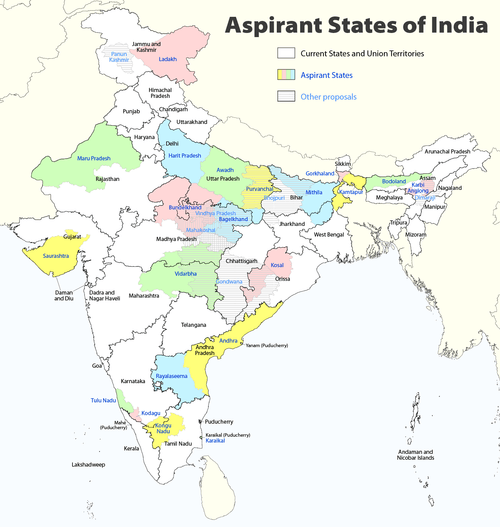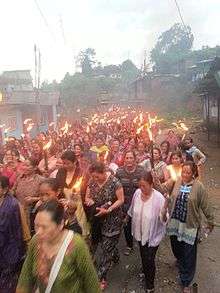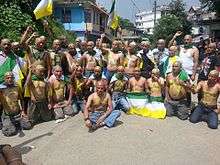Gorkhaland
| Proposed state of Gorkhaland | |
|---|---|
| Proposed state | |
| Nickname(s): The Queen of Hills | |
 Proposed state of Gorkhaland Location of Darjeeling in West Bengal  Proposed state of Gorkhaland Proposed state of Gorkhaland (India) | |
| Coordinates: 27°3′N 88°16′E / 27.050°N 88.267°ECoordinates: 27°3′N 88°16′E / 27.050°N 88.267°E | |
| Country |
|
| State | West Bengal |
| District | Darjeeling |

Gorkhaland is proposed statehood demand by the people of the hill regions of District Darjeeling Kalimpong and Duars area demanding separate state from the Indian state of West Bengal within India. The demand for a separate administrative unit in Darjeeling has existed since 1909, when the Hillmen's Association of Darjeeling submitted a memorandum to Minto-Morley Reforms demanding a separate administrative setup.[1]
History
In the 1980s, Subhash Ghisingh raised the demand for the creation of a state called Gorkhaland within India to be carved out of the hills of Darjeeling and areas of Dooars and Siliguri terai contiguous to Darjeeling. The Gorkhas have been demanding for separation from West Bengal since 1903 on the grounds that they are culturally, ethnically different from West Bengal. The demand took a violent turn, which led to the death of over 1,200 people.[2] This movement culminated with the formation of Darjeeling Gorkha Hill Council (DGHC) in 1988. The DGHC administered the Darjeeling hills for 23 years with some degree of autonomy.

A new violent movement for a separate state of Gorkhaland was started in 1986 by Gorkha National Liberation Front (GNLF) led by Subhash Ghisingh. The agitation ultimately led to the establishment of a semiautonomous body in 1988 called the Darjeeling Gorkha Hill Council (DGHC) to govern certain areas of Darjeeling district. However, in 2007, a new party called the Gorkha Janmukti Morcha (GJM) raised the demand for a separate state of Gorkhaland once again.[3]
The fourth DGHC elections were due in 2004. However, the government decided not to hold elections and instead made Subhash Ghisingh the sole caretaker of the DGHC till a new Sixth Schedule tribal council was established. Resentment among the former councillors of DGHC grew rapidly. Among them, Bimal Gurung, once the trusted aide of Ghising, decided to break away from the GNLF. Riding on a mass support for Prashant Tamang, an Indian Idol contestant from Darjeeling, Bimal quickly capitalized on the public support he received for supporting Prashant, and was able to overthrow Ghisingh from the seat of power. He went on to found the Gorkha Janmukti Morcha raising the demand a state of Gorkhaland.[4]

The demand for Gorkhaland took a new turn with the assassination of Madan Tamang, leader of Akhil Bharatiya Gorkha League. He was stabbed to death allegedly by Gorkha Janmukti Morcha supporters on 21 May 2010, in Darjeeling, which led to a spontaneous shutdown in the three Darjeeling hill sub-divisions of Darjeeling, Kalimpong and Kurseong.[5][6] After the murder of Madan Tamang, the West Bengal government threatened action against Gorkha Janmukti Morcha, whose senior leaders are named in the FIR, meanwhile hinting discontinuation of ongoing talks over interim arrangement with the Gorkha party, saying it had "lost popular support following the assassination".[7]
On 8 February 2011, three GJM activists were shot dead (one of whom succumbed to her injuries later) by the police as they tried to enter Jalpaiguri district on a padyatra led by Bimal Gurung from Gorubathan to Jaigaon. This led to violence in the Darjeeling hills and an indefinite strike was called by GJM that lasted 9 days.[8]
In the West Bengal state assembly election, 2011 held on 18 April 2011, GJM candidates won three Darjeeling hill assembly seats, proving that the demand for Gorkhaland was still strong in Darjeeling. GJM candidates Trilok Dewan won from Darjeeling constituency[9] Harka Bahadur Chhetri from Kalimpong constituency, and Rohit Sharma from Kurseong constituency.[10] Wilson Champramari, an independent candidate supported by GJM, also won from Kalchini constituency in the Dooars.[11]
Gorkhaland Territorial Administration
The memorandum of agreement for the formation of a Gorkhaland Territorial Administration (GTA), a semi-autonomous administrative body for the Darjeeling hills, was signed on 18 July 2011.[12] Earlier, during the West Bengal assembly election (2011) campaign, Mamata Banerjee had told that the Darjeeling is integrated part of Bengal. While Mamata implied that this would be the end of the Gorkhaland movement, Bimal Gurung reiterated that this was just another step towards statehood. Both spoke publicly at the same venue in Pintail Village near Siliguri, where the tripartite agreement was signed.[13] A bill for the creation of GTA was passed in the West Bengal Legislative Assembly on 2 September 2011.[14] The West Bengal government issued a gazette notification for the GTA Act on 14 March 2012, signalling preparations for elections for the GTA.[15] In the elections of the GTA held on 29 July 2012, GJM candidates won from 17 constituencies and the rest 28 seats unopposed.[16] After an agitation of about two years, the GJM also agreed to the setting up of another autonomous body, called Gorkhaland Territorial Administration. Gurung is currently the chief executive of the GTA. However, over the last few months, the GJM has expressed severe dissatisfaction over the functioning of the GTA and have revived the call for the separate state of Gorkhaland.[17]
On 30 July 2013, Gurung resigned from the GTA citing both interference from the West Bengal government and the renewed agitation for Gorkhaland.[18]
2013 agitation

On 30 July 2013, the Congress Working Committee unanimously passed a resolution to recommend the formation of a separate Telangana state from Andhra Pradesh to the INC-led central government.[19] This resulted in flaring up of demands throughout India, prominent among them were the demands for statehood for Gorkhaland in West Bengal and Bodoland in Assam.
Following a 3 days bandh,[20] GJM announced an indefinite bandh from 3 August.[21] Largely peaceful, political development took place in the background. With the West Bengal government armed with Calcutta high court order declaring the bandh as illegal, the government toughened its stand by sending a total of 10 companies of paramilitary force to quell any violent protest and arresting prominent GJM leaders and workers.[22] In response GJM announced a unique form of protest 'Janta Bandh', in which with no picketing or the use of force, the people in the hills were asked to voluntarily stay inside on 13 and 14 August.[23] This proved to be a major success and an embarrassment for the government.
After a marathon 'all party meeting' convened by the Gorkha Janamukti Morcha (GJM) on 16 August at Darjeeling, the pro Gorkhaland parties informally formed 'Gorkhaland Joint Action Committee'.[24]
2017 agitation
Between June and September 2017, there was another agitation in Darjeeling.[25] Protests first started after the West Bengal government announced on 16 May that Bengali language should be a compulsory subject in all schools across the state. This was interpreted as an imposition of an alien culture by the Gorkha Janamukti Morcha (GJM) administered area where the majority of the people speak Nepali.[26] Initially, the protests were peaceful. They were stepped up around 5–8 June when the Chief Minister was visiting the regions. After initially ignoring the situation, the Government softened its tone when the protests and rallies intensified. After a cabinet meeting at Raj Bhavan in Darjeeling on 8 June, the Government clarified that Bengali will be an optional subject in the hills. But the GJM leadership decided to not take this on face value, and intensified the protests further. The protesters then revived the old demand for a separate state of Gorkhaland.[26] On 9 June, the Government called in the para-military to control the situation.[27][28][29][30][31]
There were a few clashes between the police and the agitators initially. Strikes were called on a few occasions. The situation worsened on 15 June, when the police raided a GJM office and seized spade,sickle,bow,arrow,hoe,and shovel. This was followed by violent clashes between the police and the agitators. And following this, the GJM called an indefinite strike and shut down in the region.[26]
There were widespread instances of violence including riots, arson, torching of vehicles, government properties and houses. In one of these protests, the Darjeeling Himalayan Railway was torched by the protesters.[32] Mass rallies were taken out regularly by the supporters of the Gorkhaland agitation. There have been multiple injuries of both the Gorkhaland supporters and security personnel. A total of 11 people have died in the protests till date.[33] The internet services of the region were also suspended by the government for the duration of the shutdown.[34] There were complaints of the violation of human right in the region, and an APDR (Association for the Protection of Democratic Rights) team was sent to the region to investigate the issue.[35]
On 9 July, the protests reach New Delhi. Supporters staged a march from Raj Ghat to Jantar Mantar.[32] This was followed by the GJM rejecting the State Government’s offer of talks. On 29 August, the state Government called a meeting with the hill parties. But the meeting was fruitless and they could not arrive at a conclusion. This was followed by another round of talks where there was a consensus to end the shutdown. The supporters met the Home Minister on 19 September. This was followed by the hills slowly returning to normalcy. On 26 September, internet services were restored in the region. Then on 27 September, GJM headed by new chairperson Binay Tamang finally called off the strike after 104 days.[32]
Even after the strike was called off, there were a few stray incidents of violence and protests in the region.[33] But the region as a whole was much calmer than before. And so on 27 October, the Supreme Court directed the Centre to withdraw 7 of the 15 central armed forces deployed in the region.[36]
Bimal Gurung has been in hiding since then for fear of being arrested under the Unlawful Activities (Prevention) Act.[37][38][39]
Regional Political Parties Gorkhaland
- Gorkha Janmukti Morcha (GJM)
- Gorkha National Liberation Front (GNLF)
- Gorkha National Liberation Front (C.K. Pradhan) (GNLF-P)
- Gorkha Rashtriya Congress
- Akhil Bharatiya Gorkha League / All India Gorkha League (ABGL)
- Bharatiya Gorkha Janashakti (BGJ)
- Bharatiya Gorkha Parisangh (BGP)
- Communist Party of Revolutionary Marxists (CPRM)
Defunct Political Parties of Gorkhaland
- Sikkim Janashakti Party (SJP) {merged with Indian National Congress in 1999}
See also
References
- ↑ "The Parliament is the supreme and ultimate authority of India". Darjeeling Times. 23 November 2010. Archived from the original on 1 November 2013. Retrieved 20 March 2012.
- ↑ "Our sacrifice has gone in vain, say kin of those killed in 1980s Gorkhaland stir". Hindustan Times. 2017-06-27. Retrieved 2018-08-12.
- ↑ "Demand for Gorkhaland raised again". The Hindu. Chennai, India. 16 November 2007. Retrieved 20 March 2012.
- ↑ "Indian Idol reignites demand for Gorkhaland in Darjeeling hills". Live Mint. 19 March 2008. Retrieved 20 March 2012.
- ↑ "Gorkha leader Madan Tamang killed, Darjeeling tense". The Indian Express. 21 May 2010. Retrieved 20 March 2012.
- ↑ "Gorkha leader Madan Tamang hacked in public". The Times of India. 22 May 2010. Retrieved 20 March 2012.
- ↑ "Tamang's murder threatens to derail Gorkhaland talks". The Times of India. 26 May 2010. Retrieved 20 March 2012.
- ↑ "2 killed in police firing on GJM protesters". The Hindu. Chennai, India. 8 February 2011. Retrieved 20 March 2012.
- ↑ "GJM wins Darjeeling constituency by record margin of votes". Hindustan Times. 14 May 2011. Archived from the original on 4 November 2013. Retrieved 20 March 2012.
- ↑ "GJM wins three Assembly seats in Darjeeling". Zee News. 13 May 2011. Retrieved 20 March 2012.
- ↑ "GJMM to finalise stand today". The Statesman. 13 May 2011. Archived from the original on 11 March 2012. Retrieved 20 March 2012.
- ↑ "Darjeeling tripartite pact signed for Gorkhaland Territorial Administration". The Times of India. 18 July 2011. Retrieved 20 March 2012.
- ↑ "Gorkhaland struggle may not end with Mamata's deal". First Post. 20 July 2011. Retrieved 20 March 2012.
- ↑ "GTA Bill passed with 54 amendments". The Times of India. 3 September 2011. Retrieved 20 March 2012.
- ↑ "Gorkha Territory readies for polls". The Times of India. 15 March 2012. Retrieved 20 March 2012.
- ↑ "GJM sweeps maiden GTA polls, not to give up Gorkhaland demand". Darjeeling Times/IANS. 2 August 2012. Retrieved 5 August 2012.
- ↑ Sailen Debnath, The Dooars in Historical Transition, ISBN 9788186860441
- ↑ "After Telangana, GJM ratchets up Gorkhaland demand". Yahoo News. 30 July 2013. Retrieved 3 August 2013.
- ↑ "UPA finally grants Telangana; Hyderabad common capital". Rediff. 30 July 2013. Retrieved 19 September 2018.
- ↑ http://zeenews.india.com/news/west-bengal/telangana-effect-gjm-calls-for-bandh-in-darjeeling-hills-for-gorkhaland_865170.html
- ↑ http://www.ndtv.com/article/india/telangana-effect-gorkha-janmukti-morcha-calls-indefinite-shutdown-in-darjeeling-399204
- ↑ http://isikkim.com/2013-8-gta-councillor-arrested-in-kalimpong-13/
- ↑ http://www.myrepublica.com/portal/index.php?action=news_details&news_id=59469
- ↑ "Pro Gorkhaland organizations to remain on path of Darjeeling movement under GJAC name". The Times of India. 16 August 2013.
- ↑ "GJM ends 104-day strike: All about Darjeeling crisis, Gorkhaland demand". hindustantimes.com/. 2017-09-27. Retrieved 2017-11-17.
- 1 2 3 "Demand for Gorkhaland: How Bengali language derailed peace in Darjeeling". hindustantimes.com/. 2017-06-15. Retrieved 2017-11-17.
- ↑ "Centre rushes 400 more paramilitary to Darjeeling; total 1,400". The Economic Times. 2017-06-15. Retrieved 2018-07-17.
- ↑ "Darjeeling crisis: Centre rushes 400 more paramilitary personnel to restore normalcy". Hindustan Times. 2017-06-15. Retrieved 2018-07-17.
- ↑ "Gorkhaland Protest: West Bengal Writes To Centre For 10 Companies Of Paramilitary Force CRPF". NDTV.com. Retrieved 2018-07-17.
- ↑ "Darjeeling unrest: GJM, BJP adopt resolution for separate Gorkhaland; 600 paramilitary personnel rushed to hills". The Indian Express. 2017-06-13. Retrieved 2018-07-17.
- ↑ "Gorkhaland unrest: Home ministry orders withdrawal of 1,000 paramilitary personnel from Darjeeling - Firstpost". www.firstpost.com. Retrieved 2018-07-17.
- 1 2 3 ScoopWhoop (2017-09-27). "Here's A Timeline Of 104-Day Long Gorkhaland Agitation That Ended Today". ScoopWhoop. Retrieved 2017-11-17.
- 1 2 Majumdar, Arkamoy Dutta (2017-10-05). "Gorkhaland: BJP leaders visit Darjeeling, claims credit for ending 104-day strike". livemint.com/. Retrieved 2017-11-17.
- ↑ "Darjeeling unrest : GJM demands restoration of Internet services in hills". Firstpost. 2017-07-20. Retrieved 2017-11-17.
- ↑ "SILIGURI | APDR team to visit hills over violation of human rights | The Echo of India". The Echo of India. Retrieved 2017-11-17.
- ↑ Rajagopal, Krishnadas (2017-10-27). "Supreme Court allows Centre to withdraw half of its forces from trouble-hit Darjeeling, Kalimpong". The Hindu. ISSN 0971-751X. Retrieved 2017-11-17.
- ↑ "As NIA initiates preliminary enquiry in Darjeeling, Bimal Gurung, in hiding, welcomes move". The Indian Express. 2017-11-05. Retrieved 2018-07-23.
- ↑ "Darjeeling abandoned: Bimal Gurung hiding, CM Mamata Banerjee playing waiting game, MP Ahluwalia missing". India Today. Retrieved 2018-07-23.
- ↑ "SC order dismissing GJM leader Bimal Gurung's plea seeking protection from arrest could alter political calculus in hills - Firstpost". www.firstpost.com. Retrieved 2018-07-23.
Sources
- Ed. Poddar, Prem; Prasad, Anmole (2009). Gorkhas Imagined: Indra Bahadur Rai in Translation. Mukti Prakashan. ISBN 978-81-909354-0-1.
- Subba, Tanka Bahadur (1992). Ethnicity, State, and Development: A Case Study of the Gorkhaland Movement in Darjeeling. Har-Anand Publications & Vikas Publishing House. ISBN 0-7069-5695-8.
- Roy, Barun (2012). Gorkhas and Gorkhaland. Parbati Roy Foundation. Archived from the original on 2013-01-10.
- Samanta, Amiya K. (2000). Gorkhaland Movement: A Study in Ethnic Separatism. APH Publishing. ISBN 81-7648-166-1.
- Lama, Mahendra P. (1996). Gorkhaland Movement: Quest for an Identity. Department of Information and Cultural Affairs, Darjeeling Gorkha Hill Council.
- Kumar, Braj Bihari (1998). "10. Gorkhaland Imbroglio". Small States Syndrome in India. Concept Publishing Company. ISBN 81-7022-691-0.
- Chaklader, Snehamoy (2004). Sub-Regional Movement in India: With Reference to Bodoland and Gorkhaland. K.P. Bagchi & Co. ISBN 81-7074-266-8.
- Samdara, Ranbir (2005). "7. Silence Under Freedom: Darjeeling Hills". The Politics of Autonomy: Indian Experiences. SAGE. ISBN 0-7619-3452-9.
- Chadha, Vivek (2005). "16. Gorkhaland Movement". In United Service Institution of India. Low Intensity Conflicts in India: An Analysis. SAGE. ISBN 0-7619-3325-5.
- Kaushik, Anupma (2007). Gorkhaland Revisited. Navjeewan Publication. ISBN 81-8268-029-8.
- Why Gorkhaland. Gorkha Janmukti Morcha. 2009.
- Debnath, Sailen. West Bengal in Doldrums. ISBN 978-81-86860-34-2.
- Debnath, Sailen. Essays on Cultural History of North Bengal. ISBN 978-81-86860-42-7.
- Debnath, Sailen. The Dooars in Historical Transition. ISBN 978-81-86860-44-1.
External links
| Wikimedia Commons has media related to Gorkhaland. |